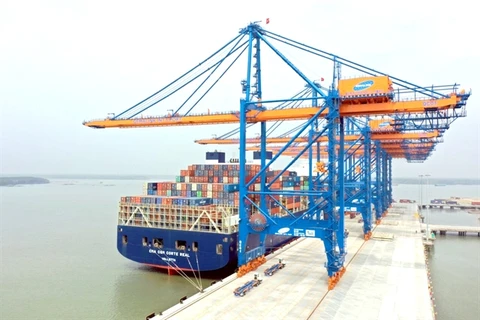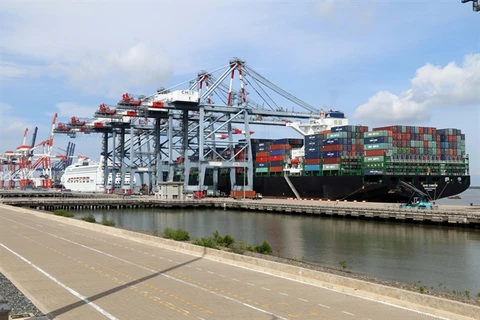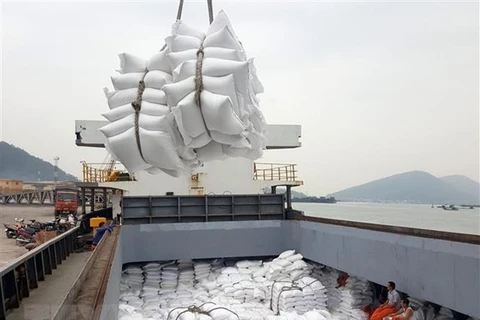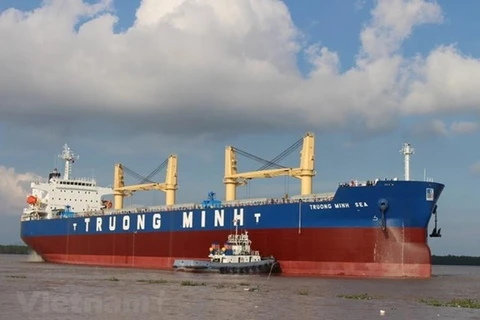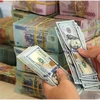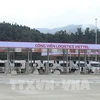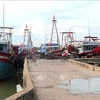 Container ship CMA CGM CORTE REAL docks at GERMALINK port in the southern province of Ba Ria-Vung Tau. (Photo: VNA)
Container ship CMA CGM CORTE REAL docks at GERMALINK port in the southern province of Ba Ria-Vung Tau. (Photo: VNA) Hanoi (VNA) – Freight rates and surcharges in addition to the price of container shipping services by sea of foreign shipping lines in Vietnam have increased rapidly and uncontrollable in recent time in the context that Vietnamese enterprises are struggling with other increasing expenses due to the COVID-19.
Ambiguous in fee and charge declaration
The results of an inspection into CMA-CGM – a France container shipping company show that listed prices and surcharges other than sea freight rates are incorrect and do not reflect actual rates. This has caused a galloping increase of the shipping freight charges in recent time.
The same situation was also observed at all the eight other foreign shipping lines that have been inspected, including MSC (Switzerland-Italy), OOCL (Hong Kong), Hapag-Lloyd (Germany), ONE (Japan), Evergreen (Taiwan), HMM (the Republic of Korea), Maersk Lines (Denmark) and Yangming (Taiwan). These are holding a large share of Vietnam's container shipping to America and Europe.
According to deputy head of the Vietnam Maritime Administration (VMA) Hoang Hong Giang, listed freight rates do not reflect actual ones.
He noted that listed surcharges only show the price, do not specify the time for starting and ending the application. The price is decided by shipping companies without registration and declaration to Vietnam’s authorised agencies.
The inspection also shows that on average, each company applies about 3-5 types of surcharges for imported and exported goods. They are mainly charges for documents, container cleaning (for imports), and lead clamping (for exports).
Rates of surcharges are set by shipping lines themselves without any agreement with their customers. Among them, some types of surcharges are not based on the actual cost of services, such as the tonnage declaration surcharge at 30-50 USD, while shipping lines almost do not spend money on this service.
How to manage real charges
Many container shipping lines have announced further increases in transportation fees starting from late May, causing difficulties for Vietnamese import-export companies.
Germany’s Hapag-Lloyd raised the general rate increase (GRI) for routes from East Asia (including Vietnam) to the US and Canada to 960 USD per 20 feet container and 1,200 USD per 40 feet container starting from May 15.
The Swiss shipping line MSC raised sipping surcharges to 800 USD per container from May 18.
According to Duong Thanh Lan, Deputy Director of Blue Sea Cargo Logistics Transport Corporation, freight rates for the route to the US saw the biggest increases.
Shipping lines said this was due to stockpiles at ports, enterprises wanted to speed up shipping, especially to the US, which pushed up transportation demand as well as freight rates.
Truong Tien Dung, Director of Sai Gon Aquatic Products Trading Joint Stock Company said that despite increases in transportation fees, it would be impossible to negotiate for increases in products prices because the COVID-19 pandemic made consumers in markets like the US and the EU tighten their budget and focus mainly on essential goods and products with reasonable prices.
High transportation fees were eating into companies’ profits, he stressed.
Giang said the inspection results showed that shipping lines operated in accordance with the provisions of Vietnam's Law on Competition.
However, he noted that they simultaneously increased their prices at the same time when the transport market fluctuated, causing the freight rates to rise worldwide.
Currently, the shipping of Vietnam’s exports to and imports from American and Europe markets lies in the hands of foreign shipping lines.
In order to improve the State management of charges and activities of foreign shipping lines when doing business in Vietnam, the Vietnam Maritime Administration proposed the Ministry of Transport ask the Government assign the ministry to review and supplement regulations in order to improve the effectiveness of State management over foreign container shipping lines operating in Vietnam.
Foreign shipping lines have been required to register transport routes, schedules and quantity of goods, he said./.

